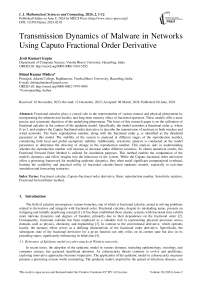Transmission Dynamics of Malware in Networks Using Caputo Fractional Order Derivative
Автор: Jyoti Kumari Gupta, Bimal Kumar Mishra
Журнал: International Journal of Mathematical Sciences and Computing @ijmsc
Статья в выпуске: 2 vol.10, 2024 года.
Бесплатный доступ
Fractional calculus plays a crucial role in the representation of various natural and physical phenomena by incorporating the inherent non-locality and long-term memory effect of fractional operators. These models offer a more precise and systematic depiction of the underlying phenomena. The focus of this research paper is on the utilization of fractional calculus in the context of the epidemic model. Specifically, the model considers a fractional order ρ, where 0<ρ≤1, and employs the Caputo fractional order derivative to describe the transmission of malware in both wireless and wired networks. The basic reproduction number, along with the fractional order ρ, is identified as the threshold parameter in this model. The stability of the system is analysed at different stages of the reproduction number, considering both local and global asymptotic stability. Additionally, sensitivity analysis is conducted on the model parameters to determine the direction of change in the reproduction number. This analysis aids in understanding whether the reproduction number will increase or decrease under different scenarios. To obtain numerical results, the Fractional Forward Euler Method is utilized for simulation purposes. This method enables the computation of the model's dynamics and offers insights into the behaviour of the system. While the Caputo fractional order derivative offers a promising framework for modelling epidemic dynamics, they often entail significant computational overhead, limiting the scalability and practical utility of fractional calculus-based epidemic models, especially in real-time simulation and forecasting scenarios.
Fractional calculus, Caputo-fractional order derivative, Basic reproduction number, Sensitivity analysis, Fractional forward Euler method
Короткий адрес: https://sciup.org/15019077
IDR: 15019077 | DOI: 10.5815/ijmsc.2024.02.01
Список литературы Transmission Dynamics of Malware in Networks Using Caputo Fractional Order Derivative
- Podlubny I., “Fractional Differential Equations”, Volume 198, Mathematics in science and engineering, Academic press,1999.
- Baleanu D., Balas V.E., and Agarwal P., “Fractional Order Systems and Applications in Engineering”, Academic press, 2023, ISBN: 978-0-323-90953-2.
- Baskonus H.M., Bulut H., “On the numerical solutions of some fractional ordinary differential equations by fractional Adams-Bashforth-Moulton method”, DE GRUYTER, 2015; 13:547-556.
- Mouaouine A., Boukhouima A., Hattaf K., and Yousfi N., “A fractional order SIR epidemic model with nonlinear incidence rate”, Advances in Difference Equations (2018) 2018:160, https://doi.org/10.1186/s13662-018-1613-z.
- Chen Y., Liu F., Yu Q., and Li T., “Review of fractional epidemic models”, Appl Math Model. 2021 Sep; 97: 281–307.
- Kermack W.O., and McKendrick A.G., “A contribution to mathematical theory of epidemics”, 1927.
- Mishra B.K., and Keshri N., “Mathematical model on the transmission of worms in wireless sensor network”, Applied Mathematical Modelling 37 (2013) 4103–4111.
- Mahata A., Paul S., Mukherjee S., and Roy B., “Stability analysis and Hopf bifurcation in fractional order SEIRV epidemic model with a time delay in infected individuals”, Partial Differential Equations in Applied Mathematics. 2022 Jun; 5: 100282, https://doi.org/10.1016%2Fj.padiff.2022.100282
- Swati and Nilam, “Fractional order SIR epidemic model with Beddington-De Angelis incidence and Holling type II treatment rate for COVID-19”, Journal of Applied Mathematics and Computing, 2022; 68:3835-3859.
- Mahata A., Paul S., Mukherjee S., Das M., andRoy B., “Dynamics of Caputo Fractional Order SEIRV Epidemic Model with Optimal Control and Stability Analysis”, Int. J. Appl. Comput. Math (2022) 8:28.
- Upadhyay R.K., Iyenger S.R.K., “Introduction to mathematical modelling and chaotic dynamics”, CRC press, Taylor and Francis group, 2019.
- Odibat Z.M., Shawagfeh N.T., “Generalized Taylor’s formula”, March 2007, Applied Mathematics and Computation 186(1):286-293.
- Halder K., and Mishra B.K., “e-Epidemic Models on the Attack and Defense of Malicious Objects in Networks”, In book: Theories and Simulations of Complex Social Systems (pp.117-143),Edition: Volume 52, Intelligent Systems Reference Library, Publisher: Springer Berlin Heidelberg, October 2013.
- Castilla-Chavez C., Feng Z., and Huang W., “On the Computation of R_0 and its Role on Global Stability”, M-1553, February 2001.
- Ahmed E., El-Sayed, El-Saka Hala A.A., “On some Routh-Hurwitz conditions for fractional order differential equations and their applications in Lorenz, Rössler, Chua and Chen systems”, Physics Letters A 358(1):1-4, October 2006.
- La Salle J.P., “The stability of dynamical systems”, Soc. Indust. Appl. Math. (1976).
- Shuai Z., VanDen Driessche P., “GLOBAL STABILITY OF INFECTIOUS DISEASE MODELS USING LYAPUNOV FUNCTIONS”, SIAM J. APPL. MATH, Vol. 73, No. 4, pp. 1513–1532, 2013.
- Diekmann O., Heesterbeek J.A.P., Roberts M.G., “The construction of next-generation matrices for compartmental epidemic models”, J R Soc Interface, 2010 Jun 6;7(47):873-85.
- Van Den Driessche P., Watmough J., “Reproduction numbers and sub-threshold endemic equilibria for compartmental models of disease transmission”, Math Biosci. 2002 Nov-Dec; 180:29-48.
- Li C., and Zeng F., “Numerical methods for fractional calculus”, Chapman & Hall, CRC Press, Taylor & Francis group, 2015.


